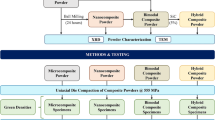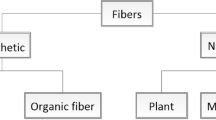Conclusions
-
1.
A compact of a material from knitted gauzes constitutes, because of its loop structure, a spring-like fibrous'skeleton exhibiting a targe elastic aftereffect, which manifests itself even in the course of sintering.
-
2.
In the production of materials of low porosity and predetermined thickness it is preferable to employ a process consisting of double sintering with intermediate pressing, which enables pressing to be carried out at a lower pressure and facilitates the attainment of the required thickness.
-
3.
Sintering under pressure is the most effective method of producing high-porosity materials of predetermined thickness from knitted gauzes.
-
4.
The strength of vacuum-sintered porous materials from knitted gauzes grows as their sintering temperature approaches the melting point of the material of their fibers. The optimum sintering time lies in the range 2.5–3.5 h.
-
5.
During sintering in a vacuum partial loss of material from the fiber surfaces is observed, the extent of which grows with increase in porosity.
Similar content being viewed by others
Literature cited
M. Yu. Bal'shin, Scientific Principles of Powder and Fiber Metallurgy [in Russian], Metallurgiya, Moscow (1972).
V. S. Ivanova et al., “Fibrous materials,” in: Metal Science and Heat Treatment 1965, Advances in Science” and Technology [in Russian], VINITI Akad. Nauk SSSR, Moscow (1966), pp. 5–69.
C. Z. Carroll-Porczynski, Advanced Materials, Astex Publishing Corp., Guildford, England (1962).
I. N. Frantsevich et al., Composite Materials of Fibrous Structure [in Russian], Naukova Dumka, Kiev (1970)
A. G. Kostornov, I. M. Fedorchenko, et al., “Sintering of metal fiber materials,” Poroshk. Metall., No. 1, 41–46 (1972).
A. G. Kostornov, V. V. Skorokhod, and M. S. Shevchuk, “Changes in dimensions of porous metal fiber materials subjected to pressing and sintering,” Poroshk. Metall., No. 2, 7–14 (1972).
R. A. Andrievskii, Porous Powder Metallurgy Materials [in Russian], Metallurgiya, Moscow (1964).
I. N. Frantsevich et al., “Fiber materials with an oriented structure based on tungsten and molybdenum,” in: Composite Materials — Materials of the Future [in Russian], KhFTI, Kharkov (1969), pp. 13–26.
K. D. Mikhailov et al., Knitting Technology [in Russian], Gizlegprom, Moscow (1956).
A. P. Dubrovskii and V. I. Bakarinova, “Sintered permeable materials,” in: Powder Metallurgy in Modern Engineering [in Russian], Nauka, Moscow (1968), pp. 22–36.
Author information
Authors and Affiliations
Additional information
Translated from Poroshkovaya Metallurgiya, No. 9(177), pp. 38–43, September, 1977.
Rights and permissions
About this article
Cite this article
Karpinos, D.M., Rutkovskii, A.E., Zorin, V.A. et al. Production of porous permeable materials with a prearranged structure from continuous metal fibers. Powder Metall Met Ceram 16, 685–689 (1977). https://doi.org/10.1007/BF00791468
Received:
Issue Date:
DOI: https://doi.org/10.1007/BF00791468




